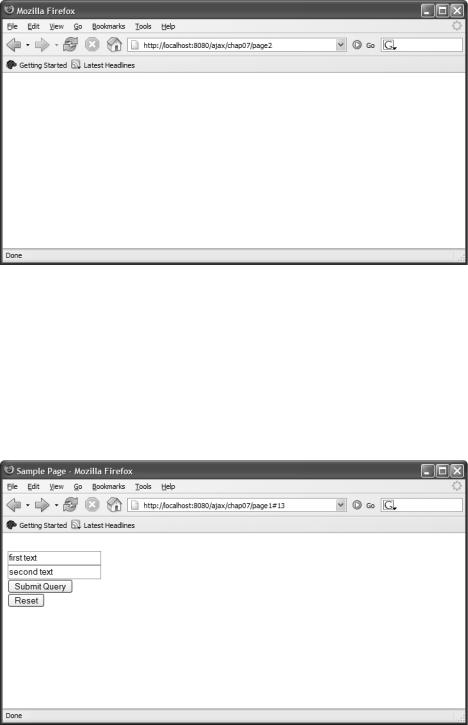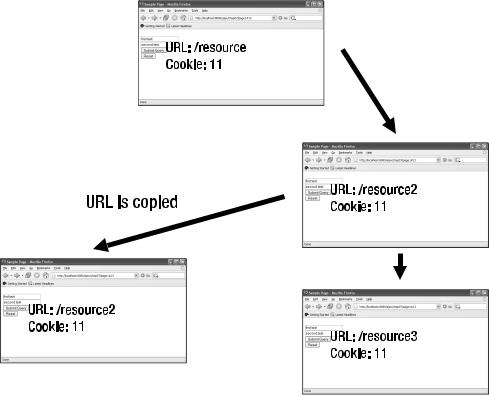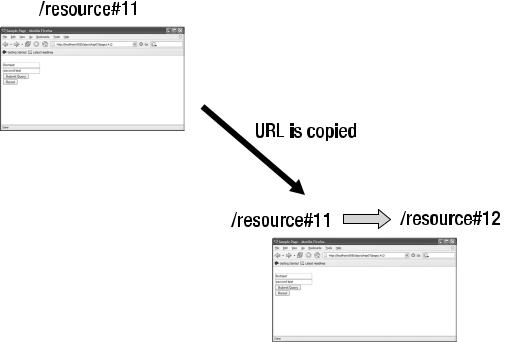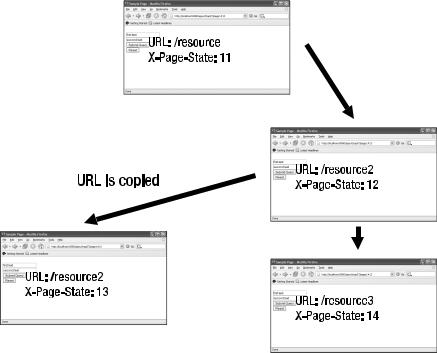
Ajax Patterns And Best Practices (2006)
.pdf
C H A P T E R 9 ■ S T A T E N A V I G A T I O N P A T T E R N |
269 |
Figure 9-4. Initial HTML page
In Figure 9-4, the HTML page has two text boxes and two buttons and is called an HTML form. Implementing the Permutations pattern by using an HTML form is a challenge from a resource definition perspective. Contrast the HTML form to a traditional HTML page. When Mary Jane (for example) reads an e-mail entry, the Permutations pattern is applied on the contents of the e-mail entry. The resource is the URL http://mydomain.com/mailbox/maryjane/ entry1234, and the representation is a transformation of the e-mail entry to content that the client wants. The resource and representation of the e-mail entry cannot be edited or modified.
When the Permutations pattern is applied to an HTML form, the HTML form without any content is the representation of a resource. The URL http://mydomain.com/resource/step1 is an example resource that maps to the HTML form http://mydomain.com/resource/ step1.html. The end user fills in the form, and a state is created. If the end user were to press the Back button and then the Forward button on the web browser, the created state would be lost (to avoid losing the state, most browsers “remember” the HTML form element contents). The problem is that the resource URL is for an empty HTML form representation. To remember the state, another URL (for example, http://mydomain.com/resource/step1/state/1234) needs to be defined. Defining a new URL is not a problem, and this topic is covered shortly. What needs to be noted is that editable HTML pages have multiple resource URLs that are dependent on the state.
So the problem in Figure 9-4 is how to associate a state with the resource (the example illustrated uses a URL). The association cannot be embedded in an HTTP header or HTML text field or cookie because that would violate the intent of the State Navigation pattern and the general design of URLs. But even simpler, when a URL is copied and pasted into another browser, there is no chance of copying and pasting a cookie, HTTP header, or HTML text field. Therefore, the state or reference to the state must be in the URL.

270 |
C H A P T E R 9 ■ S T A T E N A V I G A T I O N P A T T E R N |
The solution of associating a state with a resource is to use a special URL, but one that is specialized by using a state identifier. Figure 9-5 illustrates an example HTML page that has been specialized by using a state identifier. For reference purposes, the state was loaded by the XMLHttpRequest object using the Content Chunking pattern.
Figure 9-5. Initial HTML page with session state loaded
In Figure 9-5, the HTML page has loaded the associated session state. Comparing Figure 9-4 and Figure 9-5, you would not be able to tell because almost nothing has changed. The one change is the appending of the text #11, which is used to indicate the state identifier.
When a URL is associated with a hash character, the browser considers the new URL as unique but does not force a refresh of the browser. For example, if the URL were http:// mydomain.com/ajax/chap07/page1/state/11, the HTML page would have been reloaded and the server would have been responsible for associating the HTML form state with the HTML page. The problem with changing the URL to associate a state is that it forces a reload for each and every state. A redirection occurs, and the web application is complicated and potentially prone to fail or load the wrong content. Using the # character does not require a reloading of the HTML page. The # character is ideally suited to be used in the context of the Content Chunking pattern because a script can parse the URL and extract the state identifier. The script then uses the XMLHttpRequest type to retrieve the state from the server and saves it in the HTML page. From the perspective of the server, there exists only the HTML form with no content, and the state. The client-side script associates the state with the HTML form. Do remember that state does not have to be associated with an HTML form, but could be associated with an HTML page that is transformed by using the Representation Morphing pattern.
Going back to Figure 9-5, if the user were to enter some data in the text boxes and then click the Submit Query button, the HTML page in Figure 9-6 would result.

C H A P T E R 9 ■ S T A T E N A V I G A T I O N P A T T E R N |
271 |
Figure 9-6. Second page resulting from processed page
Figure 9-6 is plain vanilla because there is nothing to display. This figure illustrates the process of saving state and loading another HTML page that does not have any state. What happened is that the script saved the state of the previous page and posted the state to the server. After the state was successfully posted, the next HTML page was retrieved by using standard navigation techniques. Separating the posting of the state and retrieving of the next appropriate content solves many problems, with one being the unnecessary dialog box illustrated in Figure 9-3. When the user clicks the Back button, the state in Figure 9-7 is displayed, illustrating the State Navigation pattern.
Figure 9-7. Original page1 is reloaded with last known state
272 |
C H A P T E R 9 ■ S T A T E N A V I G A T I O N P A T T E R N |
Looking closer at Figure 9-7, you can see several changes, namely the text boxes are filled with some text, which is the state, and the state identifier has changed to 13, from 11. At this point, you could click the Forward and Back buttons as many times as you wanted; the state would be constantly reloaded, while the state identifier would update itself.
Extending the Solution for a Web Application
The presented solution illustrates how the hash character can be used to load and save the state of an individual HTML page. The individual HTML page or resource saves state on the server side that can be combined into a series of HTML pages that are related to each other.
When stringing together multiple HTML pages that are related, problems can occur with a web browser, and two problems are pronounced. The first problem relates to multiple browsers attempting to access the same content that has a state. When this situation occurs, the state associated with the content is dependent on the timing of what content is submitted by one of the browsers. The second problem relates to navigating content by using the Forward and Back buttons, as that can wreak havoc on content that has an associated state.
To illustrate the problem of multiple browsers displaying the same content, let’s go through an example. The example will navigate through the resources /resource, /resource2, and /resource3. If users navigated the resources individually, or in an ad-hoc fashion, the web application would have no idea how to manage the state because there is no order to the navigation. To provide order, the resources are strung together by using cookies that manage which resources are called and the state of the called resources. But the HTTP cookies give a false sense of security. The problem is that HTTP cookies do not distinguish between different web browser instances. It does not mean that cookies cannot be used, but they cannot be the reference point used by the server to manage the state of the resources. However, a solution using cookies will not be illustrated because the focus is on the page transitions and managing of the state.
Getting back to the problem of being unable to distinguish between a browser window instance, that problem is best illustrated in Figure 9-8.
In Figure 9-8, the initial browser loaded the URL /resource, and some content was generated. After the user fills in the HTML form and clicks Submit Query, the state of the URL /resource is saved, and /resource2 is loaded. Having loaded /resource2, the user decides to open another browser and copies the URL /resource2 to the second browser that is loaded. At this moment, there are two browser instances that loaded the same content, and both browsers reference the same cookie identifier. Where the server becomes confused is when the user switches back to the first browser, fills in the data, and clicks the Submit Query button, causing /resource3 to be loaded.

C H A P T E R 9 ■ S T A T E N A V I G A T I O N P A T T E R N |
273 |
Figure 9-8. Processing multiple pages in a web application by using cookies
The confusion with an HTTP cookie occurs when the first web browser loads the representation associated with the resource /resource3, while the second web browser loads the resource /resource2. If the second browser attempts to navigate to the resource /resource3, the server will become confused as to what stage the web browser is really at. The server cannot distinguish between browser instances, and therefore overwrites new data over old, or old data over new, causing consistency problems. The behavior of the cookie is correct, as the cookie specification explicitly says that a cookie is associated with a domain and not a browser instance.
Using a state identifier to manage the state and resources creates a solution in which the state is accumulated. Accumulation of state makes it possible to fork the state if multiple browsers are accessing multiple versions of the state. To understand the logic, consider Figure 9-9, which indicates how unique state identifiers are created.

274 |
C H A P T E R 9 ■ S T A T E N A V I G A T I O N P A T T E R N |
Figure 9-9. An example of the state identifier being updated after the URL is copied to another web browser instance
In the upper-left corner of Figure 9-9 is a web browser that has downloaded some content with the URL /resource#11. The loaded content is the resource /resource with the state identifier 11. Imagine the user opening a second browser and copying the link /resource#11. The State Navigation pattern will load the resource /resource and the state associated with the identifier 11. In the second browser, the state identifier is updated to reference 12. If the second browser has the same state identifier as the first, that binds both browsers to the same state and creates concurrency problems. Imagine that the client modifies the state in the first browser; then the second browser would see the same state. This is not desirable, and therefore the state identifier 11 is copied to a new state identifier 12. Then the first and second browser instances for the time being have the same state values, but different references.
The solution in Figure 9-9 needs one additional twist to make it work properly. If the browser were to request the URLs /resource#11 and /resource#12, the resource /resource would be issued twice. This relates back to the purpose of the hash character, which is a reference to a link on an HTML page. This is a good thing, because the State Navigation pattern has separated the resource from the state of the resource. So when the resource /resource#11 is called, the URLs /resource (for example, HTML page) and /resource/state (for example, HTML page state) are called.
By using the XMLHttpRequest object, it is easy to separate the two URL requests, and there are multiple ways to implement the two URLs. But using two URLs is not enough. You also need to use HTTP headers to uniquely identify the request. Figure 9-10 illustrates how Figure 9-8 is fixed by using HTTP headers.

C H A P T E R 9 ■ S T A T E N A V I G A T I O N P A T T E R N |
275 |
Figure 9-10. Rearchitecting multiple resources to use a state identifier
In Figure 9-10, each of the web browser instances is a URL, with a hash code–identified state identifier that is converted into an X-Page-State HTTP header. Each instance of the web browser has an HTTP header that is unique. This is a good thing because now, even though there are two browsers, the resource /resource2 has two separate instances of the associated state.
Having the unique state identifiers works, except it exposes another problem: there is no stringing together of the individual HTML pages to build a web application. What we don’t know is how the states relate to each other. Visually, we know that the states 11, 12, and 14 are a single chain. And visually we know that 11 and 13 are another chain. But the server does not know that because the server does not know that state 13 is the result of opening a second browser.
To finish the solution, the history of the URLs is needed. The web browser has that information because it is required for navigating the Forward and Back buttons. The simple solution would be to access the browser-exposed history object and pass those URLs to the HTTP POST. The problem with the simple solution is that it is not generally viable. Accessing the history object by using a script is a security issue, and unless the client has allowed access, will generate an exception.
A more feasible solution is to add an additional HTTP header that uniquely identifies the window used to chain together the HTML pages. Specifically, the property window.name can be assigned and is ideally suited to uniquely identify the individual HTML windows. Figure 9-11 illustrates the final solution.

276 |
C H A P T E R 9 ■ S T A T E N A V I G A T I O N P A T T E R N |
Figure 9-11. Final solution used to uniquely identify the HTML windows, URL, and associated state
In Figure 9-11, each browser window instance is unique and can be identified. For example, if the user requests /resource, the window identifier is A, and the state identifier is 11. If the user processes the data, /resource2 is retrieved with a new state identifier 12 and window instance A. If the user were to copy the URL to a new browser instance, the URL /resource2#12 would be copied. The state identifier 12 would be loaded, but the window browser instance is B, and therefore the server knows a new window instance has been created, and a new history is being generated. The server will then associate the state 11 with the newly created state identifier 13. Now both browser instances, A and B, both share the state identifier 11 in their history. Then if the user clicks the Submit Query button of either window, A or B, two unique results will occur that do not conflict with each other. If the example were a plane ticket application, two tickets that start at the same location but end in different locations could be purchased.
A new state identifier is created when the page is refreshed. Considering that we can identify the browser instance by using the window name, the state identifier is not necessary. Using a window name as a state identifier creates a state that is accumulated and organized by resource. When a new browser instance and old URL are copied (for example, state identifier 13), the server is responsible for copying the old state into a new state. The downside of using an accumulated state is that it is not as fine-grained as a state identified by unique identifiers.
C H A P T E R 9 ■ S T A T E N A V I G A T I O N P A T T E R N |
277 |
Managing State at the Protocol Level
Moving down one level on the technological scale, this section illustrates the HTTP communications between the client and server. The communications are started by having a web browser ask for the resource http://mydomain.com/ajax/chap07/page1, which is illustrated by the following request. Note that the illustrated requests and responses are abbreviated and show only the HTTP information that is relevant for the discussion:
GET /ajax/chap07/page1 HTTP/1.1
Accept: text/xml,application/xml,application/xhtml+xml,text/html;q=0.9, text/plain;q=0.8,image/png,*/*;q=0.5
Accept-Language: en-us,en;q=0.5 Accept-Encoding: gzip,deflate
Accept-Charset: ISO-8859-1,utf-8;q=0.7,*;q=0.7
The server accepts the request and responds with the following:
HTTP/1.1 200 OK
ETag: W/"1017-1126885576349"
Last-Modified: Fri, 16 Sep 2005 15:46:16 GMT
Content-Type: text/html
Content-Length: 1017
Server: Apache-Coyote/1.1
In the response, there is an ETag indicating that the content could be cached by the web browser. If the ETag were sent in response to an XMLHttpRequest request, the Cache Controller pattern could have been used. The server-generated response uses the Permutations pattern and contains information that can be represented by a web browser. The generated response represents the empty or generic representation that does not contain a state. When the generated content has been converted into a processed HTML page, the HTML body onload event is triggered. Triggering the onload event generates a request for the state associated with the resource. Following is the XMLHttpRequest-generated request:
GET /ajax/chap07/page1/state HTTP/1.1
Accept: application/xml
Accept-Language: en-us,en;q=0.5
Accept-Encoding: gzip,deflate
Accept-Charset: ISO-8859-1,utf-8;q=0.7,*;q=0.7
X-Page-Window-Name: window-2005-10-03-10-10-10-1245
X-Page-State: none
What is unique in the request for the state from the XMLHttpRequest object is that the URL is similar in structure to the resource URL, except that the state keyword is appended to the URL. The state keyword is necessary so that all proxies and browsers can uniquely identify the resource and the state associated with the resource. Using the same URL would cause problems. In the HTTP request, the additional HTTP headers X-Page-State and X-Page-Window-Name are used. The header X-Page-State defines the state identifier, and the header X-Page-Window-Name identifies the name of the window asking for the state. What triggers the server-side State Navigation pattern implementation is either the appended state identifier or the X-Page-State HTTP header. More about the trigger will be discussed in the server-side code implementation.
278 |
C H A P T E R 9 ■ S T A T E N A V I G A T I O N P A T T E R N |
And last, notice how the Accept HTTP header accepts only the type application/xml. This is on purpose even though a MIME type such as application/ajax-state would have been more appropriate. It is critical to use application/xml because then the XMLHttpRequest and web browser will recognize the returned data as XML. Using another MIME type causes the XMLHttpRequest type to not parse the generated XML and returns the content only as a text stream. As an architectural side note, a format such as JSON could be used to define the state.
When asked for a state for the first time, the server will not have an associated state and will need to create an empty state. The empty state response is illustrated as follows:
HTTP/1.1 200 success
X-Page-State: 11
Date: Sun, 18 Sep 2005 11:19:30 GMT
Server: Apache-Coyote/1.1
In the response, the server issues an HTTP 200 command to indicate that the request was a success. The body may be empty, but in the case of the example would be the XML <state></state> to indicate an empty state. An empty state is generated so that the requesting client can go through the hoops of asking for a state, but nothing will be modified. The HTTP header X-Page-State is returned to the client to indicate what the state identifier is, and in this case the state identifier 11 is returned.
When associating a state with a URL, that state could be accessible from every browser regardless of location and therefore be considered a security risk. However, in this example, the state is not accessible everywhere because the URL, window name identifier, and state identifier are tied together. A hacker would have to know all three before being able to access the state. Additionally, for extra security, HTTPS or some form of authentication can be used. Depending on the nature of the state, the solution could involve using requesting IP addresses, authentication information, or even cookies.
It is important to realize that if cookies are used to authenticate a user, the usefulness of the State Navigation pattern is extremely limited. Cookies can cross web browser instances, but not different web browser types or computer locations. The better solution would be to use HTTP authentication because the web browser can ask for HTTP authentication regardless of browser or computer location.
When the HTML page and state requests have been processed, the client can fill out the form with some data. Having added all the data into the form, the user can click the Submit Query button. Clicking the button causes the onsubmit event to be triggered, which results in the State Navigation pattern implementation on the client side to call the server by using the XMLHttpRequest object. The call generates a request that is illustrated as follows:
POST /ajax/chap07/linkToPage2.xml HTTP/1.1
Accept: application/xml
Accept-Language: en-ca
Accept-Encoding: gzip, deflate
Content-Type: application/xml
Content-Length: 364
Connection: Keep-Alive
Cache-Control: no-cache
X-Page-Original-Url: /ajax/chap07/page1
X-Page-Window-Name: window-2005-10-03-10-10-10-1245
X-Page-State: 11
